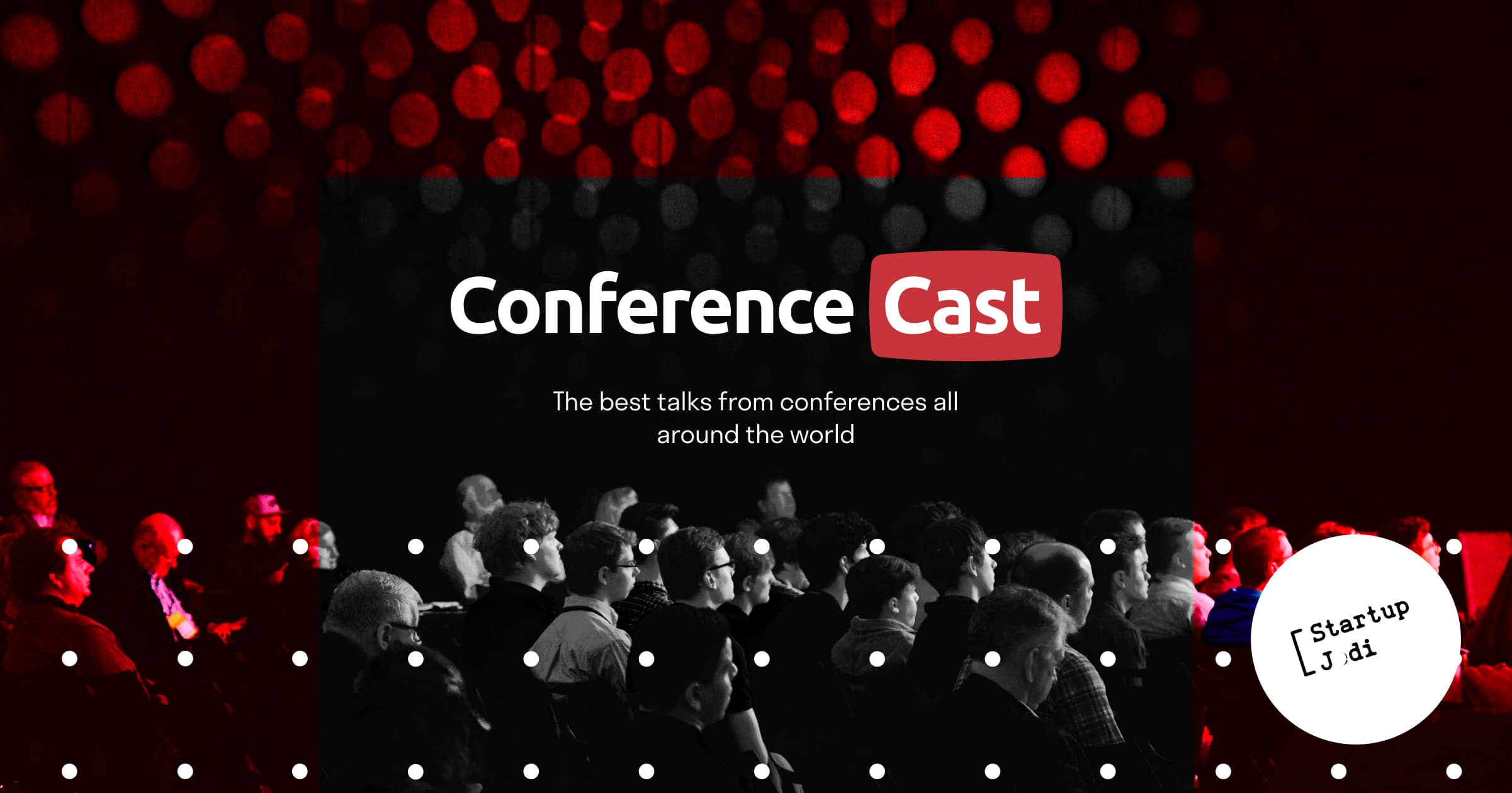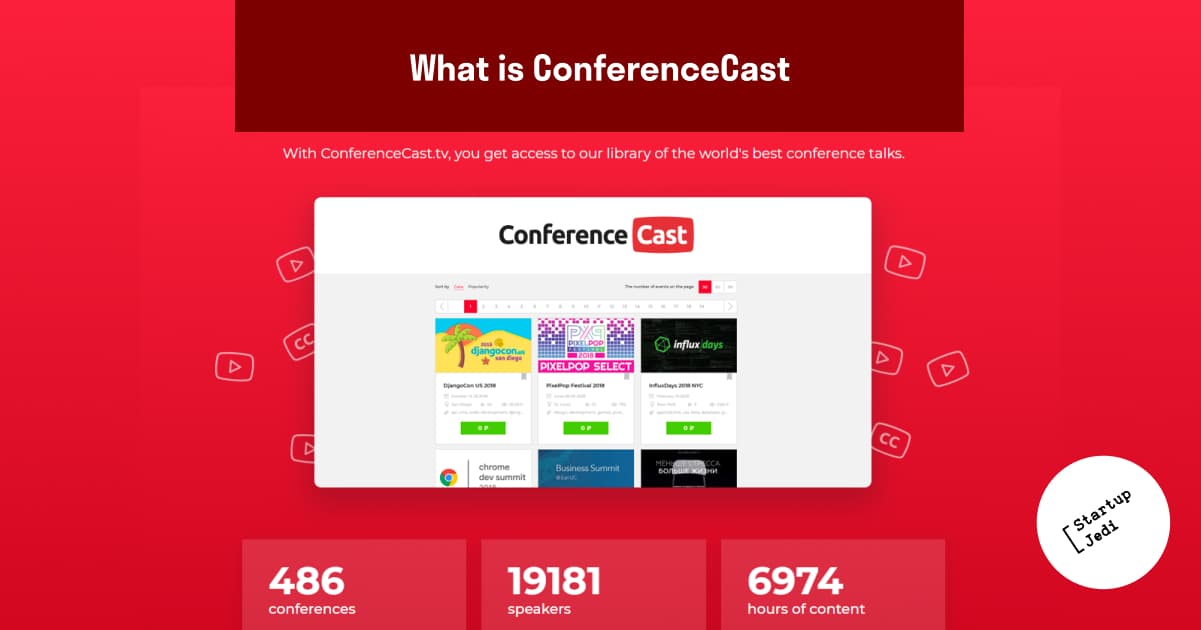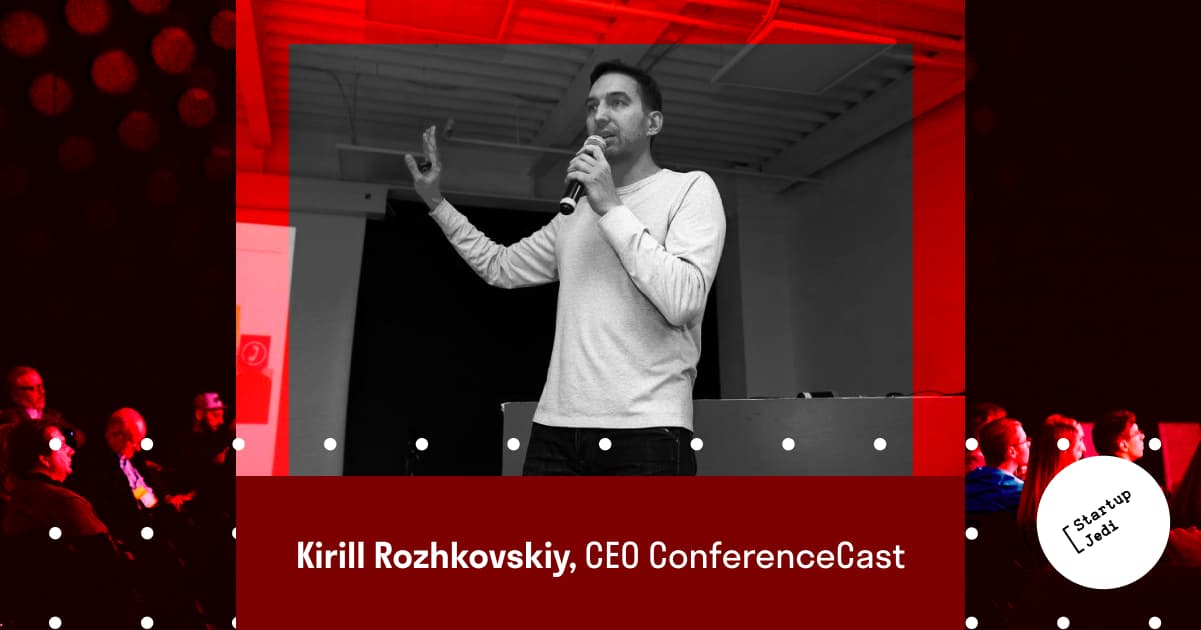
Startup Jedi
We talk to startups and investors, you get the value.
The idea to create a service for conference organisers came to Kirill Rozhkovskiy more than 10 years ago. The guy wanted to implement it in two different startups, both times he tried to reach the American market. Nonetheless, the companies were closed even though they had clients and traction. His new project is ConferenceCast.tv - a platform that aggregates conferences’ videos and allows middle-scale events’ organisers to get up to 30% from the tickets sales. What’s more, when the interview was taken, the startup was on the development stage and was just considering the pilot projects. Due to the pandemic, the situation has changed drastically in less than a month. ConferenceCast is about to start 10 collective projects. In the interview, Kirill Rozhkovskiy told us how it feels to close two own startups and what changes are currently affecting the conference market in the USA.

Startup Jedi
We talk to startups and investors, you get the value.
In 2009, I launched OMyConf — an application for making new acquaintances at various meetings. In just a year, it turned into a platform that was converting all the convertible activities into digits — starting from attendees registration and badges printing to the organization of networking, polls and questions to the speakers as well as a mobile application. The service was developing rapidly in Russia. However, when we decided to enter the American market, we ran out of money and did not manage to attract new investments. Only now I realized the strategy was wrong. Like many other startups back then, we thought that at first, the project should be tested and the money raised in Russia, and only after that, it should start conquering the USA. This was a mistake.
Monetization turned out to be our second weak spot. We were just providing our services and receiving money for that. Event organisers paid quite reluctantly, after all, those were additional expenses for the business and the value of mobile access to the event information and all the services for its participants in 2010 were visible only to the most advanced organisers.
I envisioned the platform development differently, for example, by adding recordings of the presentations to create a new income flow for the conferences. Unfortunately, at that time the project was already living its last moments. Thus, I decided to shut it down. Later we managed to attract little angel investments and I started implementing my idea with recordings in a new project.
ConferenceCast.tv was launched in 2013. The investments were raised thanks to business angels and accelerators, then we created the MVP and started getting content rapidly. It turned out that a huge number of conferences were making recordings but did nothing with them. In summer 2014, we were aiming to enter the US market. The crisis happened though and the investor, whose money we were relying on, started having financial issues. The previous investors were not able to help us as well.
I continued seeking investments, minimized all the possible expenses: only one person left in the team, a few others were helping from time to time. In 2015, when the last investment option failed, ConferenseCast was closed. We agreed with the partners upon the partition of intellectual property. I received the rights for the brand; the codes and all the groundwork could be used by all partners and investors (however, no one ever used it).
I went on hiring and started to create a new version of the project. In a year, I found a developer-partner and officially re-launched the startup. In 2017 a new, made from scratch MVP appeared on the market. In summer, the first business angel was found, and along with them a full team: CTO and two developers. From that point, began the new project history that continues up to now.
...

Earlier — before the crisis — hosts of the conferences had two tasks: to record high-quality videos from the event and to introduce it properly to their audience, so those who missed the opportunity to be present there in person, were interested enough to buy the presentations in the recording. Now though (in April 2020) the only task the industry has is simply to survive. Public events are in the state close to the heart attack. The mass event cancellation began at the beginning of March. Some of the organisers were hoping to hold the events online on approximately the same dates but failed due to the lack of experience. As a result, most of the events are postponed to the late summer — early fall. The minority announces online versions starting from the end of May. However, there is a feeling that not so many understand that there are already a huge number of events planned in fall — all the postponed ones plus those originally taking place around that time. Consequently, even now there are doubts that all these events will be in demand or it will be possible to conduct them due to the lack of platforms. What is more, the economic recession has already started: companies are cutting off their budgets, and the time when they were buying tickets for ₽20–30 thousand for their employees has passed already.
The majority of fall events are more likely to be hybrid, which means a combination of on- and off-line parts. The core of the online part is, of course, video-broadcast. However, it is important to find a solution to attract remote participants in typical offline activities: getting to know each other, the opportunity to ask speakers, take part in debates, etc. And moreover — the interaction between partners and sponsors.
The pandemic has become in some sense a present for us. First of all, the demand for online events increased significantly. Currently, it brings us clients to attract whom, it would take us months normally. Secondly, regardless whether it is us who makes the broadcasting (and all other services) or other contractors, now every (online) conference automatically has presentation recordings and something has to be done with that. And we are the best in doing this “something”.
Currently, we are implementing two strategies. The first is a partnership with streaming companies, in which terms, we are publishing the events’ content conducted on their platform. The second — cooperation with organisers to get the clients directly. To do so, we are launching our own streaming platform that will allow organisers and participants to get wholesome experience at every stage of the event.
As for now, we are working on 4 pilot projects in the USA. 10 more (online + hybrid) are on the development stage (planned in the nearest 3–4 months). Part of the events planned for spring are postponed to fall. I believe, in May we will have the first real launches in a new paradigm where we offer organisers the full cycle (broadcasting + mobile application to integrate the participants + post access to the recordings). Besides, there will appear clients who have already conducted an event and would like to continue selling the recordings.
The crisis will drastically change the attitude towards online products and the payment distribution from the revenues of virtual access before and after the event. If earlier 75% sales from the access to the video occurred before the event and only 25% — after, when the industry comes back to its more or less normal functioning, I believe, the balance will shift to approximately 50/50. And this will change the correlation of the organisers’ income flow. The demand for the recorded content will not be marginal anymore and will be popular among a great number of professionals.
...

We offer a platform for organising conference broadcasting and access to the recordings after the event in the format that is convenient for the clients. For example, all the recordings are organised according to the schedule with “search” and “filter” options available. Every recording has an annotation that allows a viewer to find out the content in just a few seconds and access the most interesting topic. Moreover, there are separate audio-tracks for podcast fans, decrypted recordings (for those who enjoy reading or needs the text version of the presentation), content search, short info about a speaker; it is also possible to add useful materials they were using during presentations.
Our main difference from other hostings (including YouTube) is how we aggregate and provide information. We do it in a way that it is convenient to use. And we are doing all of it instead of event organisers, therefore making their task easier. What is important, we have a cool white label solution that allows organisers to publish content under their label.
Ultimate consumers can watch presentations and whole sessions for free or buy access to some parts (pay-per-access). In future, we would like to end up having a subscription access model. Before the pandemic, the average price to access the whole conference in the USA cost $200–400. Now we expect a small decrease (10–15%) as the demand and organisers costs (in comparison to offline format) become lower. Nevertheless, with our help, organisers will be able to make up 30% plus by selling videos before and after the event. According to our calculations, it is around $100.000 in the USA.
We estimated that before the pandemic only 10% of all the conferences in the USA were recording the videos, and even less were selling them. After the pandemic highest point and before offline events will get their credibility back, we believe 100% of the players left will make recordings.
We are not asking for exclusiveness to publish videos. However, if the partner wants to earn money, it is obvious that the same content should not be available for money and for free at the same time. Our business model — revenue distribution. We take 15% of sales via the white label and 30% of sales from ConferenseCast.tv. While we are building the content library and the portal audience, the main sales source will be conference organisers’ resources. Nevertheless, our goal is to have the biggest amount of sales through our marketplace.
...
In February 2019 the startup got into Starta accelerator. In Russia, we already had an approved business model with around 50 paid conferences from 8 clients, the majority of which were with us for more than 2 seasons. The main goal of the acceleration I envisioned was to get the first clients in the US.
During the acceleration period, we managed to get leads. We had drafts for pilot projects but they didn’t pop-up because of various reasons. For instance, one client wasn’t satisfied with our agent contract. We prepared the documents by ourselves with the help of Russian lawyers who assured us they had already prepared such kinds of contracts for startups before. In the end, we had to remake the contract, and so to say, American lawyers set the price of $7 thousand for this.

While communicating with event organisers, I faced the issue that there was a big percent of those who did not understand what we were doing. But those who understood liked the output. It means that we had an issue with pitching our message and product values and understanding of the real organisers’ problems. After the acceleration program, Starta team helped us by introducing us to the b2b-sales expert. Together we did a great job that helped us to suppress those gaps in presenting our value and to build a wholesome mechanism of cold sales via emails. In particular, he advised:
Set up an email chain from 3–4 contacts with conference organisers where we will show the value of our product, show successful case-studies and get acquainted with the product closer;
Add LinkedIn active outreach to the email, create content and interesting posts in LinkedIn: inform about the market trends, useful tools and enclose the value of the product;
Get connected with a few new contacts inside the organisation alternately. For example, to start with the marketing department managers, then move to the conference producers and, if this doesn’t work, go to the next contact within the company;
Form individual scripts to make offers more precise and in different verticals. For example, form 3–4 client target groups and write an individual script of the email-chain, where it is told how we have already helped to solve problem A of company B precisely in their industry;
If we fail to establish the contact, we can try to contact the companies or conferences in 3–4 months. It is possible that their priorities will change by that time and the solution will be more relevant.
Right now we are on the fundraising stage. Due to the obvious reasons our attractiveness to the investors has increased. We are negotiating with investors from the USA and Russia. By the way, the money from Russian private investors is not as toxic as it is believed to be.
Facebook: facebook.com/StartupJedi/
Telegram: t.me/Startup_Jedi
Twitter: twitter.com/startup_jedi
Comments